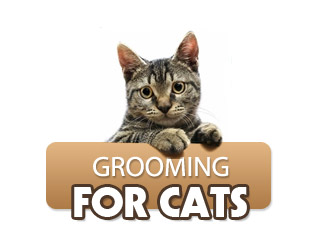Tips For Grooming Your Cat
 |
You can keep your cat from having a "bad hair day" by regularly brushing and combing his hair. Cats have many types of coats, but all of them need to be brushed and combed. |
 |
|
Some shorthair cats, such as the Bengal or Russian Blue, have sleek hair that's flat against their bodies. Shorthair cats, such as the Exotic or Manx, have thick hair with dense or cottony undercoats. Longhair cats, such as the Turkish Angora or Norwegian Forest cat, have soft, silky hair that is easy to brush and comb while others, such as the Persian, have coarse hair with an undercoat that knots up more frequently. Some cats, such as the Devon or Selkirk Rex, have curly hair. Even though you'll never have to give a curly cat a perm or put his hair up in rollers, you'll still have to brush and comb him regularly. |
|
 |
|
The combo brush will keep your cat from developing painful knots, often difficult to remove without the services of a professional groomer. If your cat must be shaved due to excessive knotting, a veterinarian must perform the procedure, and your cat will have to be anesthetized. |
|
 |
|
1. Grooming helps minimize the formation of hairballs – hair that a cat ingests as he washes himself. If a hairball lodges in your cat's digestive tract, it may require surgery to remove. 2. Combing and brushing helps you detect fleas which deposit dark bits of feces, commonly called "flea dirt," on your cat. Timely detection of fleas is necessary before the fleas infest your cat and your home. The most efficient way is to use the flea comb to brush out fleas. 3. Brushing your cat means less vacuuming because more hair will be trapped by your cat's hair brush and less hair will be deposited on the carpet. 4. Regular grooming sessions are a way to spend quality time with your cat. Grooming should be as much fun for your cat as playtime. |
|
 |
|
| The right grooming tools will make the job easier. Have a variety of grooming equipment available based on your cat's coat type and use them concurrently. Combs can be used in conjunction with brushes. Start first by combing your cat, then follow by brushing your cat to distribute the natural oils throughout his hair. |
|
 |
|
| 1. Cats that run from an owner wielding a brush may be more accepting of a grooming glove that you wear on your hand. The tiny prongs on the glove's surface remove loose hair as you gently stroke your pet. 2. Another alternative to a brush is a device that fits into the palm of your hand and is easily concealed from your skittish kitty. Made of rubber with tiny projections, the palm-held rubber brush enables you to groom your cat without him being the wiser. 3. If your cat develops a knot in his hair, remove it carefully by using a seam ripper. Keep your fingers between your cat's skin and the knot so you don't pull it. Start at the outside of the knot and gradually loosen the hair with the seam ripper as your work your way in. 4. To make grooming more appealing to your cat, store the brushes and combs in a plastic bag with loose catnip. 5. Give your cat the opportunity to groom himself by attaching a corner-mounted comber to a wall at your cat's eye-level. Sit back and watch your cat have a blast on the corner-comber. |
|
 |
|
Tips For Grooming Your Cat
